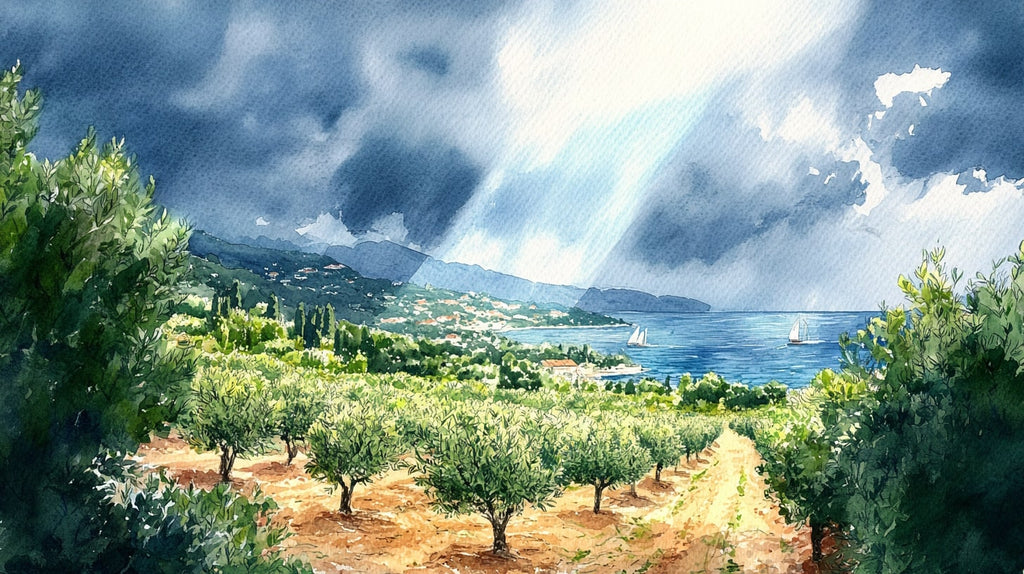When it comes to choosing high-quality olive oil, climate plays a surprisingly significant role. From the cooler climates of Croatia to the warmer regions of Spain and North Africa, the way olive oil develops is directly influenced by the environment in which the olives grow. But how exactly does climate affect olive oil quality? And what should you know if you're a discerning olive oil buyer?
In this article, we’ll explore how climate impacts olive oil production, the key differences between cooler and warmer regions, and why the oleic acid composition of olive oil is an important factor to consider—whether for taste, health benefits, or even how the oil behaves in your fridge.
The Role of Climate in Olive Oil Production
Olive trees thrive in Mediterranean climates, but the range of temperatures they’re exposed to can vary significantly. These variations influence the fatty acid composition, taste, and overall quality of the oil.
In cooler climates, olive trees grow more slowly, and this can impact the oil’s fatty acid profile, often leading to oils richer in monounsaturated fats like oleic acid. Conversely, warmer climates tend to encourage the production of polyunsaturated fats, which can affect the oil’s stability and shelf life.
Below, we’ll look at how different climates impact olive oil quality by comparing key olive-growing regions around the Mediterranean.
| Region Type | Countries | Climate Characteristics | Effect on Olive Oil |
|---|---|---|---|
| Cooler Climates | Croatia, Portugal, Northern Italy, Lebanon | Cooler winters, mild summers, slower ripening | Higher oleic acid content, longer maturation time, more stable oil, rich flavor, and longer shelf life. |
| Warmer Climates | Spain, Greece, Tunisia, Morocco, Egypt | Hotter summers, mild winters, faster ripening | Higher polyunsaturated fats, shorter maturation time, oils may be less stable but offer a more intense, sometimes fruitier flavor. |
Cooler vs. Warmer Climates: How They Impact Olive Oil Quality
In cooler regions like Croatia and Portugal, the lower temperatures during the olive ripening season slow down the metabolic processes of the olive tree. This slower growth encourages the accumulation of monounsaturated fats, primarily oleic acid, which gives the olive oil its smooth texture, delicate flavor, and longer shelf life. Additionally, the cooler growing conditions can help enhance the subtle flavors, creating a more balanced and complex olive oil.
On the other hand, olive oils produced in warmer climates, such as Spain or Tunisia, tend to develop more polyunsaturated fats like linoleic acid. These oils often have a fruitier and sometimes bolder taste, but their higher polyunsaturated fat content can make them less stable over time. The faster ripening in these regions can also result in slightly different flavor profiles, often with a stronger, more assertive taste.
Why Does Oleic Acid Matter?
One of the most critical components in olive oil is oleic acid, a monounsaturated fatty acid that plays a major role in determining the oil’s quality, taste, and health benefits. Olive oils with higher levels of oleic acid are generally considered to be of higher quality because they are more stable and resistant to oxidation. This stability means they have a longer shelf life and are less likely to go rancid compared to oils with higher levels of polyunsaturated fats.
Oleic acid has been linked to numerous health benefits, including reducing inflammation, lowering the risk of heart disease, and improving cholesterol levels. This is why many nutritionists recommend olive oil rich in oleic acid as a staple of a healthy diet.
The Fridge Test: A Myth About Olive Oil Purity
You may have heard about the so-called fridge test, where people believe that storing olive oil in the fridge can determine its purity. According to the myth, if the olive oil solidifies in the fridge, it’s pure, while if it stays liquid, it may have been adulterated with lower-quality oils. However, this test has been debunked.
The reason for this is simple: different olive oils contain varying ratios of fatty acids. Oils with a higher oleic acid content (often from cooler climates) may solidify in the fridge, but this is not a definitive indicator of purity. Oils high in polyunsaturated fats, often from warmer regions, may not solidify even though they are pure and unadulterated.
Health Benefits of Monounsaturated Fats and Oleic Acid
When considering olive oil’s role in a healthy diet, it's essential to understand the importance of monounsaturated fats, particularly oleic acid. Unlike polyunsaturated fats, which can oxidize more quickly, monounsaturated fats are more stable and offer significant health benefits. Studies have shown that diets rich in oleic acid can help:
- Lower LDL (bad) cholesterol levels.
- Improve heart health by reducing inflammation.
- Provide antioxidant properties that protect cells from oxidative damage.
In short, choosing olive oil with higher oleic acid content, typically found in oils from cooler regions, can be a smart choice both for flavor and for long-term health.

The Best Olive Oil for You
Now that you understand how climate affects olive oil quality, it's clear that olive oil from cooler climates—like the olive oils produced in Croatia’s Dalmatian coast—offer unique benefits. Their higher levels of oleic acid make them ideal for health-conscious consumers, and their delicate, balanced flavors are perfect for those who appreciate fine culinary experiences.
If you're looking for an exceptional olive oil that brings together the benefits of cooler climate production and rich tradition, consider trying our family’s olive oil, produced in the pristine region of Dalmatia, Croatia. With its high oleic acid content and smooth, balanced taste, it’s the perfect choice for those who want both quality and flavor.

